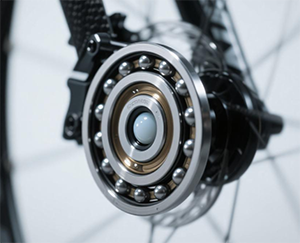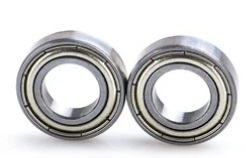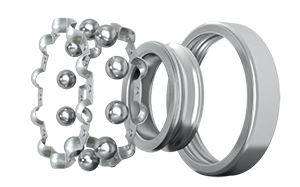
Bicycle Wheel Bearing Guide
Bicycle bearings may seem insignificant, but they play a vital role in ensuring a smooth and efficient ride. High-quality bearings can reduce friction, increase speed, and even help extend the life of your bicycle's wheel hub. By reducing friction between the bicycle's moving parts, they make pedaling easier and steering more precise.
What Is a Bicycle Wheel Bearing?

Bicycle wheel hub bearings are mechanical components consisting of small, hardened steel or ceramic balls enclosed in raceways (or sleeves). Hub bearings are located within the hub of each wheel (front and rear), typically between the axle and the hub shell. These bearings reduce friction between the axle and hub, allowing the wheel to rotate freely and smoothly.
Why Are Bearings so Important for Bicycles?
1. Improving Smoothness:
The core function of bearings is to allow moving parts (such as wheels and pedals) to rotate smoothly around their axes, effectively reducing friction and resistance. This not only makes pedaling easier and less effortful but also significantly improves riding efficiency and the overall experience.
2. Extending the Lifespan of the Vehicle:
High-quality bearings offer excellent wear and corrosion resistance, surviving harsh environments like rain, mud, and sand, and maintaining stable performance over time. Low-quality bearings, on the other hand, are more susceptible to damage and accelerate the aging of surrounding components.
3. Ensuring Cycling Safety:
The condition of bearings directly impacts the stability of critical vehicle components. Severe wear or failure can cause wheel wobble, handlebar binding, and other issues, seriously impacting handling and posing safety risks. Using high-quality bearings significantly reduces the risk of failure.
4. Improved Control Precision:
Bearings in components like the headset and bottom bracket play a crucial role in steering sensitivity and overall vehicle stability. High-precision bearings deliver a more precise and smoother handling experience, especially on curves and in complex terrain.
Types of Bicycle Wheel Bearings
Ceramic Bearings:

Ceramic bearings, typically made from materials such as silicon nitride, are known for their low rolling resistance and exceptional durability. They are significantly lighter and harder than steel bearings, allowing them to rotate with minimal friction. Riders typically notice a smoother, quieter ride, especially at high speeds. Their corrosion resistance makes them particularly well-suited to wet or humid conditions. While they carry a higher price tag, their performance advantages are significant, especially for competitive cyclists.
Chrome Steel Bearings:

Chrome steel bearings remain the most common and affordable option. Made from hardened steel, they provide reliable performance and are easy to repair or replace. While they may not be as smooth or lightweight as ceramic bearings, they are durable and reliable when properly cared for, making them a reliable choice for everyday riders and commuters.
Hybrid Bearings:
Hybrid bearings offer a middle ground, combining ceramic balls with steel raceways. This design reduces friction compared to all-steel bearings while maintaining durability and at a more reasonable cost than full-ceramic bearings. For cyclists who want a significant performance boost without committing to full ceramic bearings, hybrid bearings strike a clever balance between cost-effectiveness and efficiency.
Ceramic vs. Steel Bearings – Which Is Better?
| Feature | Ceramic Bearings | Steel Bearings |
| Material | Silicon nitride or other advanced ceramic compounds | Chrome steel or high-carbon bearing steel |
| Weight | Lighter | Heavier |
| Rolling Resistance | Extremely low; smoother rolling | Slightly higher, but still efficient |
| Corrosion Resistance | Excellent; ideal for wet, humid, or corrosive environments | Moderate; can rust if not properly maintained |
| Durability | Long-lasting under high-speed, low-impact conditions | Highly durable; better for impact and rough terrain |
| Maintenance | Requires precise installation; low maintenance after setup | Easy to service, clean, and replace |
| Cost | High; premium pricing | Affordable; budget-friendly |
| Best Use Cases | Road racing, triathlon, time trials, performance-focused riding | Commuting, MTB, everyday use, training rides |
| Beginner Friendly | Not recommended; high cost and specific installation needs | Very beginner-friendly; simple and accessible |
| Promotional Angle | Ideal for riders chasing top-level performance and efficiency | A reliable, low-maintenance choice for practical cycling needs |
How to Maintain Bicycle Bearings

1. Focus on Quality and Compatibility
Before purchasing bearings, ensure they offer excellent wear resistance, are water- and dust-resistant, and can withstand specific environments (such as heat, humidity, dust, and high loads). The bearing size and type must be precisely matched to the bicycle's structure to prevent premature wear and failure.
2. Regularly Inspect Key Areas
High-load areas such as wheel bearings, bottom brackets, and head tube headsets should be regularly inspected for looseness, unusual noises, or resistance. If wear, binding, or other issues are detected, they should be replaced promptly to prevent compromising the stability and safety of the entire vehicle.
3. Scientific Lubrication and Protection
For non-sealed bearings, it is recommended to use high-quality, specialized bearing grease and relubricate regularly. Excessive lubrication can increase resistance, while insufficient lubrication can damage the bearings. Therefore, the maintenance interval should be adjusted flexibly based on riding frequency and the environment (such as humidity or dust).
Signs You Need to Replace Your Bike Wheel Bearings
Play in the hub: If you feel any side-to-side movement or wobbling when you grip and shake the wheel, it often means the bearings or their adjustment are compromised.
Rough rotation: When spinning the wheel by hand, it should turn smoothly and quietly. Any grinding, roughness, or resistance suggests worn bearings.
Creaking or unusual noises: Squeaks, clicks, or creaking sounds during riding can indicate bearing damage or contamination.
How to Test Bearing Condition at Home
Spin the wheel: Lift the bike so the wheel spins freely. Listen carefully for roughness or noise, and feel if the rotation is smooth.
FAQ
How often should you replace bicycle wheel bearings?
Typically, bearings last between 3,000 to 10,000 miles depending on riding conditions and maintenance. If you notice roughness, play, or noise, it’s time for a replacement.
Can I upgrade to ceramic bearings anytime?
Yes, but ensure your hubs are compatible and the installation is precise. Ceramic bearings offer lower friction but come at a higher cost.
Do wheel bearings affect bike speed?
Absolutely! High-quality, well-maintained bearings reduce friction and improve rolling efficiency, helping you ride faster with less effort.